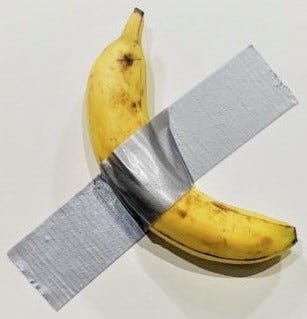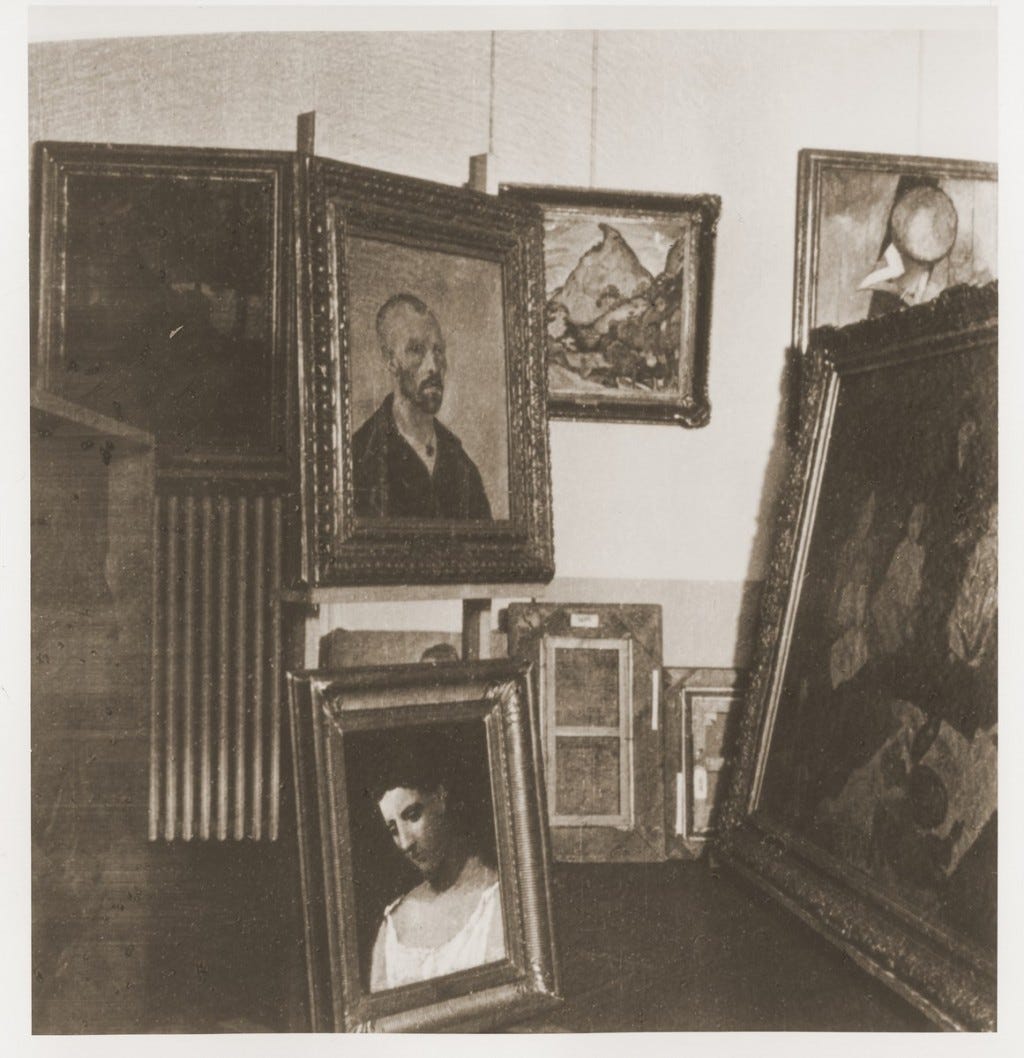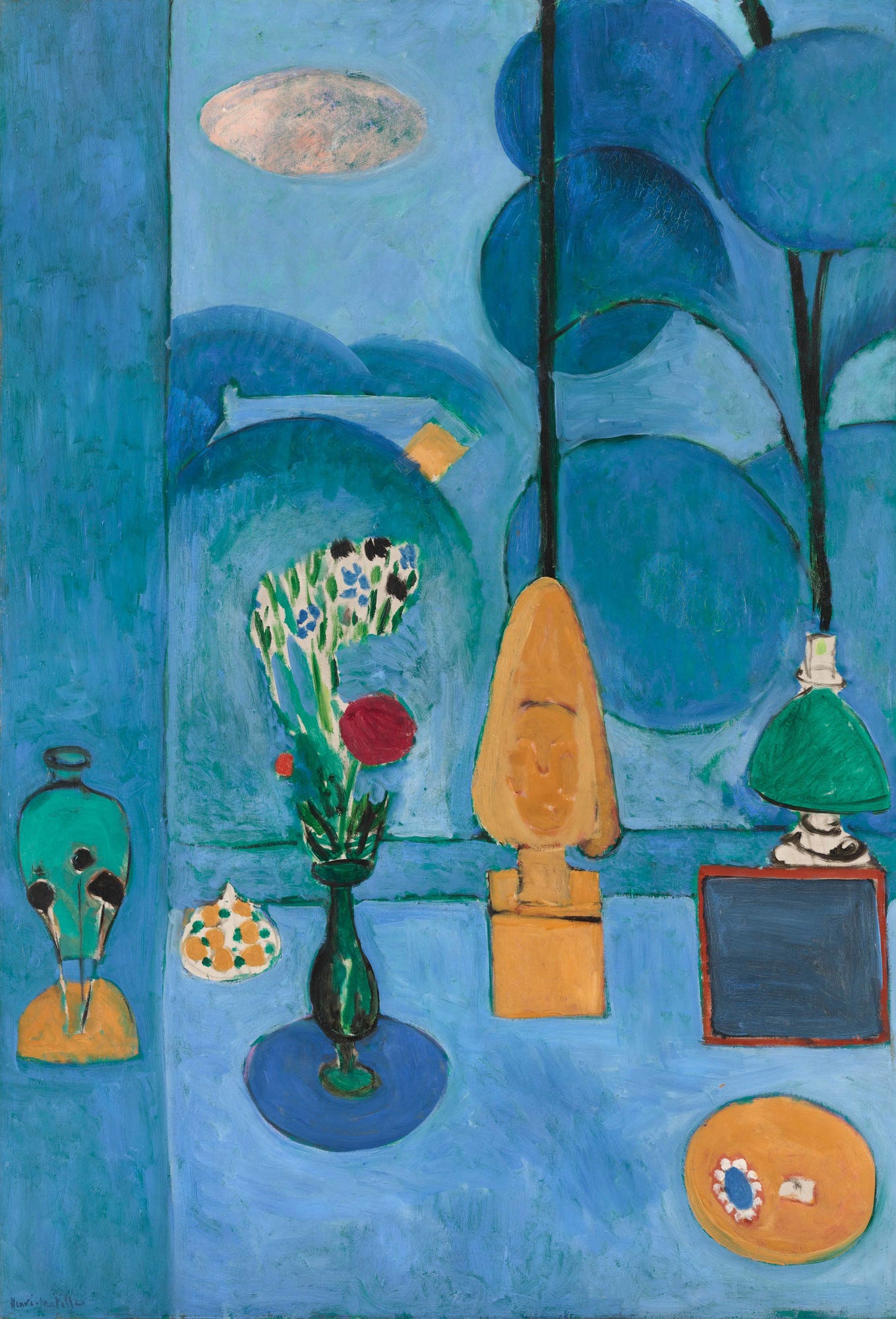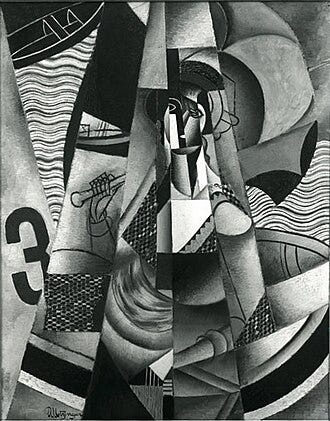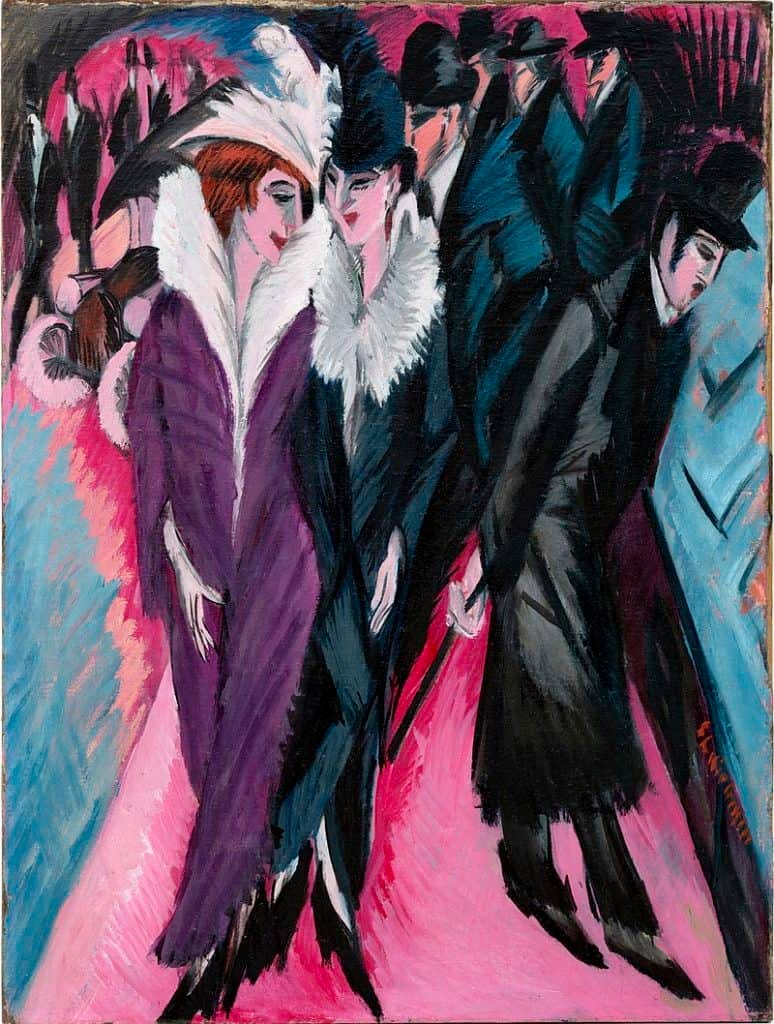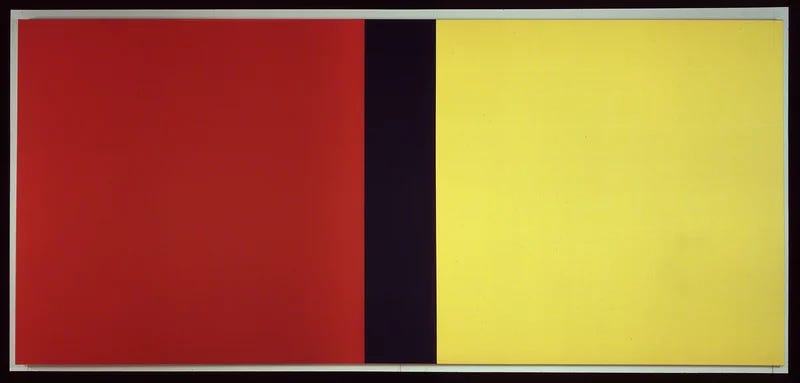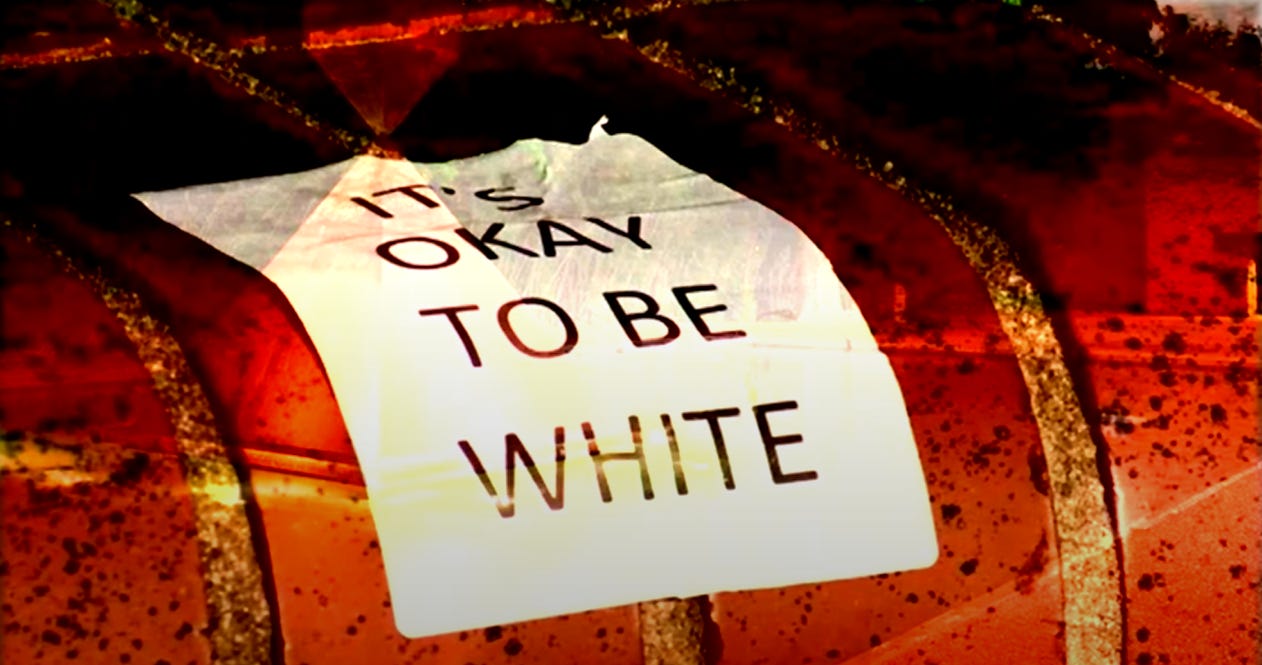How does a painting die? Sometimes, it gets forgotten, fading into obscurity. Other times, it gets murdered.
Who’s Afraid of Red, Yellow and Blue III, a painting by the American post-war artist Barnett Newman, was murdered.
While the painting was on display at the Stedeljik Museum, a man named Gerard Jan van Bladeren attacked Who’s Afraid of Red, Yellow, and Blue III with a box cutter, tracing a series of long slashes through the center of the canvas. When the slashes were added all up together, they measured nearly fifty feet long. Van Bladeren was 31, unemployed, living with his parents, and was a painter himself- although not very successful. He considered this act of vandalism to be an artistic gesture. He saw the painting as a kind of cultural provocation, and one of the main arguments that his lawyer made in his defense was that this provocation called for a reaction and got one.
What made this painting elicit such a reaction? At first glance, it appears simple, even mundane- yet it might be this very simplicity that provokes such outrage. A massive canvas, nearly 18 feet wide and eight feet tall. On the left side, a small strip of blue, and on the right, a small strip of yellow. But the rest of the surface was painted entirely red.
Barnett Newman finished Who’s Afraid of Red, Yellow, and Blue III in 1967. It was the third in a series, and the title was a reference to Who’s Afraid of Virginia Woolf, the landmark play, which later became a movie starring Elizabeth Taylor and Richard Burton. Ironically, the public reaction to this painting provided a clear answer to the question posed by its title. Barbara Visser says that when the Stedelijk Museum acquired Who’s Afraid of Red, Yellow, and Blue III in 1969, a lot of people did not like it. “At the time people would write really long and elaborate letters to say how much they hated this painting,” she recalls. The painting elicited the kind of response that a lot of people still have to abstract art — questioning why this constituted art at all when it seems as though anyone could do that. One woman even expressed that it literally made her sick.
It’s not surprising then that many people took the murder of this painting positively, even voicing their support to it’s vandalism. Van Bladeren was sentenced to five months in prison, and stood by his actions as a defense of artistic values. Many people in the Netherlands agreed and sent letters to the Stedelijk. “This so-called vandal should be made the director of modern museums,” read one. “He did what hundreds of thousands of us would have liked to do,” read another.
Carol Mancusi-Ungaro is one of the leading experts in the field of art conservation. Mancusi-Ungaro has pioneered techniques for restoring works by modern and contemporary artists and has worked on several paintings by Barnett Newman. She says that there are a set of rules that conservators must follow when restoring a painting, the first being that you should make every effort to not use any material that cannot be removed or reversed in the future.
If conservators add paint to a canvas, they want to make sure that paint can be dissolved and removed later. They do this in case the artwork needs to be retouched again in the future. Conservators also try to preserve as much of the original material as possible, touching only the areas that need treatment. They should also really study the artist and look at their past work in order to get a sense of what the artist was trying to achieve.
With these rules in mind, the Stedelijk phoned up practically every conservator in Europe. The biggest challenge was the very simplicity of the painting. The busy texture and detail of a Picasso or a Rembrandt often help to mask repair work, but Newman’s canvas was mostly just one big swath of uniform color, so any sign of repair would stand out.
So, something strange happened once the painting was “restored.” Visitors noted that the areas that had been repainted looked “off” and “distracting.” If Newman’s work was truly just blocks of paint on canvas, what gives?
Turns out that Newman actually put thought into what he was doing. The artistry of the piece is not in his careful rendering of light and shadow on a nude figure or a still life or a great scene from the Bible or history. It is instead something arguably much harder: creating depths of color through the subtlety of paint. Newman uses all sorts of chemicals and materials to give his paint much more richness and texture than whatever you can buy at a store. He puts in meticulous effort to achieve these extremely vivid and eye-catching tones, and even the seemingly childlike composition of the colors next to each other all serve to elevate each individual color by contrasting so wonderfully with one another.
The true artistry here isn’t tied to a specific subject matter but rather emerges from Newman’s mastery of pure color, something very few others can achieve. When confronted with a work of art that seems abstract or hard to grasp, it’s worth considering not just what it represents, but the skill involved in its creation. The complexity of the process and the difficulty in replicating it often reveal just how remarkable the very process of creating artwork truly is.
In general terms, looking for non-obvious meanings of artwork can sometimes be much more rewarding than being given everything by the piece itself.
Similarly- the emotions that art inspires can be wide-ranging and seemingly limitless. Painters in the Renaissance era who were influenced strongly by the Biblical canon painted scenes which evoke reverence and divinity. “A Starry Night” was based on the wonder that Van Gogh felt when looking at the night sky and all the stars in it. Let’s go back to that banana taped to a wall (a piece called “Comedian” by Maurizio Cattelan). It may make you angry knowing that it sold for over $100,000 or that it occupies space that better art could’ve taken. But anger, confusion and outrage are all emotions too, and emotions that this piece seems to consistently create in those who look at it. Viewed from this lens, that banana taped to a wall is more successful as art than a thousand hyper-detailed Renaissance-era biblical paintings. As an aside, that piece was created as a mockery of how absurd the art world can be at times, so Cattelan would probably agree with you in how stupid or odd it is that a banana taped to a wall sold for that much.
In that sense, the fear that Who’s Afraid of Red, Yellow, And Blue III provoked has justified it’s placement in the museum, and it’s position in the art world. Who’s Afraid of Red, Yellow, And Blue III isn’t just a piece of art. It’s a question that was answered in exactly the way the artist expected it to be answered. In my opinion, it shouldn’t even have been restored. I believe that the point it tries to get across is even stronger when it is in tatters. In its pristine state it merely asks the question "who’s afraid of red, yellow and blue?", but in a damaged state it tells us exactly who, and instead asks “why are they afraid of red yellow and blue?”
In other words, the piece was finally finished by its destruction. Art gains additional meaning when it is viewed as and is allowed to be dynamic. To some extent I find "vandalism" to be a loaded term, but that’s a discussion for another day.
You might be thinking, “But who cares?” Why should the way an artwork was created matter if the end result feels banal, even ridiculous? This brings us to a popular argument against modern art- that art must contribute to society.
The idea that art must contribute to society isn’t a new opinion. In fact, it’s closely linked to a very particular political ideology- fascism.
Purveying Meaning
This is not to say that not liking modern art makes you fascist. However, fascism does make strong efforts to bring art under a rigidly bordered, “culturally appropriate” definition. There’s this pursuit, in fascism, to make everything of an “aesthetic”. And that aesthetic is simultaneously mythologized and made into the history of a culture.
Once the culture is appropriately mythologized, the art that feeds back into it is seen as “contributing” to the created society. When, for instance, every artist that the dominant ideology values for the last thousand years has been a white male, and creates things that glorify white/colonialist ideals, there’s something that starts to feel almost natural about that. It creates an hierarchy.
And any art that pushes back or pursues a different aesthetic isn’t contributing anything to that mythology anymore. And when artists pushing the different aesthetic are members of groups that have been historically oppressed by the dominant culture, the art that they create may feel like an attack on that mythology.
Or that’s how it could be framed, if one had certain political motivations. For example- the Nazis.
On one hand, you might look at Nazis and see a surprising amount of respect for artists. Joseph Goebbels called artists “gottbegnadeten sinngeber” or “a divinely gifted purveyor of meaning”. High praise, but as Barbara Fischer notes, as well as this being characteristic of the “banal and overwrought late romanticism” of the Nazis, “purveying meaning” was only acceptable when the meaning being purveyed fed back into the national mythology.
There’s little subtlety when looking at the most valued art of the Third Reich. Most interesting is the fact that, as well as the gallery full of nude boys with swords, the Nazis also showed off the art they hated, in a gallery called “Degenerate Art”.
“We now stand in an exhibition that contains only a fraction of what was bought with the hard-earned savings of the German people. All around us you see the monstrous offspring of insanity, impudence, ineptitude, and sheer degeneracy. What this exhibition offers inspires horror and disgust in us all.
-Adolf Ziegler, president of the Reich Chamber of Visual Arts
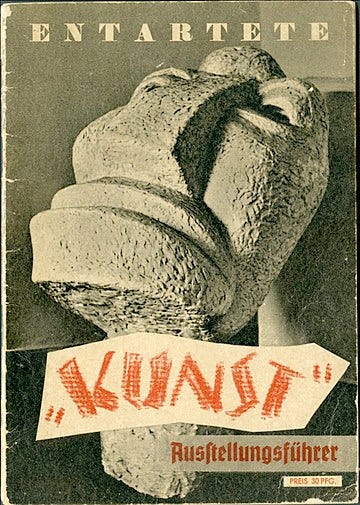
Degenerate art was a term adopted in the 1920s by the Nazis to describe modern art. During the dictatorship of Adolf Hitler, German modernist art, including many works of internationally renowned artists, was removed from state-owned museums and banned in Nazi Germany on the grounds that such art was an "insult to German feeling", un-German, Freemasonic, Jewish, or Communist in nature. Those identified as degenerate artists were subjected to sanctions that included being dismissed from teaching positions, being forbidden to exhibit or to sell their art, and in some cases being forbidden to produce art.
The “Degenerate Art” exhibit, featuring over 650 paintings, sculptures, prints, and books from the collections of 32 German museums, premiered in Munich on 19 July 1937, and remained on view until 30 November, before traveling to 11 other cities in Germany and Austria. The first room contained works considered demeaning of religion; the second featured works by Jewish artists in particular; the third contained works deemed insulting to the women, soldiers and farmers of Germany. The rest of the exhibit had no particular theme. There were slogans painted on the walls.
This gallery, full of art removed from other museums, held such deviants such as Henri Matisse, Andre Derain and Oskar Kokoschka. The following were some artworks featured in the exhibition:
If you truly thought art was causing damage to society, wouldn’t you try to hide to from everyone? But they didn’t want it to be hidden. This kind of art, the Nazis said, would only be made by insane and degenerate artists. Specifically, they said these artists must be mentally ill to create these kinds of abstractions. Alongside each peace in this exhibit were the extravagant prices they were bought for, inviting mockery and anger. The gallery made familiar claims- no one, in the right mind, would enjoy this art.
Instead, the fact that these pieces were held in high regard was indicative of the insidious plot of the left. The art held critiques of the sexual norms and family values that were so important to the Nazi notion of respectability. Modern art, they said, was also made for the “eradication of the last vestiges of radical consciousness.” New and transgressive styles by Jewish and black artists were indicative of their “degenerate intellectualism”.
Eugenics, of course. Through the systematic devaluation of art.
Barnett Newman, himself, is Jewish. For every attack on his work because people didn’t like Red, many more have been specifically done by white supremacists. Who’s Afraid of Red, Yellow and Blue IV was spit on by a man who said that it was a “perversion of the German flag.”
Another piece by Newman, a sculpture called Broken Obelisk was spray painted with swastikas in 1979, and in 2018, the same sculpture had white paint poured into it’s reflecting pool. Scattered around the vandalism were brochures with the 4chan-pioneered supremacist campaign “it’s ok to be white”.
Whether they know it or not, the fact that white supremacists hate Newman’s art fits right in with the message he always said he wanted to convey. In 1990, he said of his art:
“One of it’s implications is it’s assertion of freedom. If [it were read] properly, it would mean the end of all state capitalism and totalitarianism.
Challenging our preconceived notion of art means challenging our preconceived notions of institutions and society. This kind of art doesn’t fit into the cultural narrative and because of that, it becomes a target. And ultimately, the crime that these artists commit is the right’s biggest fear- they are upsetting the hierarchy. They are taking themes, experiences and emotions that don’t fit into our nation’s narrative and they are expressing them in a way that is impossible to ignore.
And thus, the rejection of non-tradition forms of art so often boils down to a rejection of oppressed people within those mediums. Nazis didn’t call Kokoschka a degenerate because of his artistic stylings, they did it because of his public anti-fascist activism. White supremacists didn’t vandalise Newman’s work because of the apparent simplicity of his art, they did it in an attempt to show who in society actually held power.
Patrick Buchanan, and American paleoconservative proclaimed that much of modern art was “barbarism”. Buchanan was speaking alongside Jesse Helms and was also the National Endowment for the Arts. But he cut right to what he felt was the meat of the issue- art like this, this barbarism, was a direct result of the “amorality and cowardice of art critics”.
This is the heart of it- this is the most naked form of attempting to control art. When people prescribe art to a specific set of qualities, and attack everything that lays beyond those lines, we have to understand what they’re doing. Those qualities- they just so happen to perfectly align with the dominant cultural ideology. They’re not showing respect for the craft, they’re not trying to uphold meaning. They’re enforcing a hierarchy. They’re attempting to define a cultural narrative.
And above all, they’re not talking about art.






